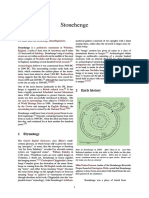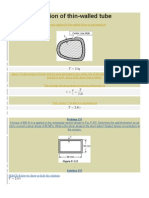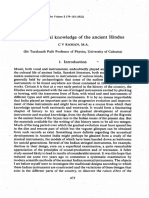Prehistoric Architecture
Prehistoric Architecture
Uploaded by
Gela0 ratings0% found this document useful (0 votes)
4 views2 pagesHistory of Architecture 1
#ARCHITECTURE GUIDE FOR ARCHITECTURE STUDENTS
Original Title
PREHISTORIC ARCHITECTURE
Copyright
© © All Rights Reserved
Available Formats
DOCX, PDF, TXT or read online from Scribd
Share this document
Did you find this document useful?
Is this content inappropriate?
Report this DocumentHistory of Architecture 1
#ARCHITECTURE GUIDE FOR ARCHITECTURE STUDENTS
Copyright:
© All Rights Reserved
Available Formats
Download as DOCX, PDF, TXT or read online from Scribd
Download as docx, pdf, or txt
0 ratings0% found this document useful (0 votes)
4 views2 pagesPrehistoric Architecture
Prehistoric Architecture
Uploaded by
GelaHistory of Architecture 1
#ARCHITECTURE GUIDE FOR ARCHITECTURE STUDENTS
Copyright:
© All Rights Reserved
Available Formats
Download as DOCX, PDF, TXT or read online from Scribd
Download as docx, pdf, or txt
You are on page 1of 2
When did Western architecture begin?
Long before the magnificent structures of
ancient Greece and Rome, humans were designing and constructing. The period
known as the Classical Era grew from ideas and construction techniques that
evolved centuries and eons apart in distant locations.
This review illustrates how each new movement builds on the one before.
Although our timeline lists dates related mostly to American architecture, historic
periods do not start and stop at precise points on a map or a calendar. Periods
and styles flow together, sometimes merging contradictory ideas, sometimes
inventing new approaches, and often re-awakening and re-inventing older
movements. Dates are always approximate—architecture is a fluid art.
11,600 BCE to 3,500 BCE — Prehistoric Times
Archaeologists "dig" prehistory. Göbekli Tepe in present day Turkey is a good
example of archaeological architecture. Before recorded history, humans
constructed earthen mounds, stone circles, megaliths, and structures that often
puzzle modern-day archaeologists. Prehistoric architecture includes monumental
structures such as Stonehenge, cliff dwellings in the Americas, and thatch and
mud structures lost to time. The dawn of architecture is found in these structures.
Prehistoric builders moved earth and stone into geometric forms, creating our
earliest human-made formations. We don't know why primitive people began
building geometric structures. Archaeologists can only guess that prehistoric
people looked to the heavens to imitate the sun and the moon, using that circular
shape in their creations of earth mounds and monolithic henges.
Many fine examples of well-preserved prehistoric architecture are found in
southern England. Stonehenge in Amesbury, United Kingdom is a well-known
example of the prehistoric stone circle. The nearby Silbury Hill, also in Wiltshire,
is the largest man-made, prehistoric earthen mound in Europe. At 30 meters high
and 160 meters wide, the gravel mound is layers of soil, mud, and grass, with dug
pits and tunnels of chalk and clay.1 Completed in the late Neolithic period,
approximately 2,400 BCE, its architects were a Neolithic civilization in Britain.
The prehistoric sites in southern Britain (Stonehenge, Avebury, and associated
sites) are collectively a UNESCO World Heritage Site. "The design, position, and
inter-relationship of the monuments and sites," according to UNESCO, "are
evidence of a wealthy and highly organized prehistoric society able to impose its
concepts on the environment." To some, the ability to change the environment is
key for a structure to be called architecture. Prehistoric structures are sometimes
considered the birth of architecture. If nothing else, primitive structures certainly
raise the question, what is architecture?
Why does the circle dominate man's earliest architecture? It is the shape of the
sun and the moon, the first shape humans realized to be significant to their lives.
The duo of architecture and geometry goes way back in time and may be the
source of what humans find "beautiful" even today.
You might also like
- History of Architecture - WikipediaDocument40 pagesHistory of Architecture - WikipediaARCHI STUDIONoch keine Bewertungen
- Stonehenge's Multiphase ConstructionDocument3 pagesStonehenge's Multiphase ConstructionTeodora RNoch keine Bewertungen
- The End of Eden: The Comet That Changed CivilizationFrom EverandThe End of Eden: The Comet That Changed CivilizationRating: 5 out of 5 stars5/5 (2)
- Prehistoric Architecture - Puro Bato 2021Document39 pagesPrehistoric Architecture - Puro Bato 2021Johann MacaballugNoch keine Bewertungen
- GB Synop. History Part 1Document23 pagesGB Synop. History Part 1Аня РалеваNoch keine Bewertungen
- Neolithic Architecture: and - Lintel and CorbellingDocument3 pagesNeolithic Architecture: and - Lintel and CorbellingSagar AroraNoch keine Bewertungen
- The Stone Age: Prehistoric Western EuropeDocument4 pagesThe Stone Age: Prehistoric Western EuropeAhmed MohammedNoch keine Bewertungen
- 1-3 Prehistoric ArchitectureDocument60 pages1-3 Prehistoric Architecturegaga100% (2)
- StonehengeDocument7 pagesStonehengeahmetediz02Noch keine Bewertungen
- 4 Simple Concepts of Prehistoric ArchitectureDocument7 pages4 Simple Concepts of Prehistoric ArchitecturepiolopxsNoch keine Bewertungen
- Group 4 Ana316 - 094836Document13 pagesGroup 4 Ana316 - 094836InnocentNoch keine Bewertungen
- Prehistoric ArchitectureDocument11 pagesPrehistoric ArchitectureCésar OliveiraNoch keine Bewertungen
- Unit 14Document1 pageUnit 14Elizabeth VegaNoch keine Bewertungen
- Relationship Between Archeoastronomy and Architecture A Multidisciplinary Approach To Modern ArchitectureDocument5 pagesRelationship Between Archeoastronomy and Architecture A Multidisciplinary Approach To Modern ArchitectureSabaNoch keine Bewertungen
- Pre-Historic Architecture: Presented By: Ruchi AroraDocument20 pagesPre-Historic Architecture: Presented By: Ruchi AroraRuchi Aayush MehtaNoch keine Bewertungen
- History CompiledDocument368 pagesHistory CompiledNishant RajputNoch keine Bewertungen
- Stonehenge - WikipediaDocument49 pagesStonehenge - Wikipedia13933138024Noch keine Bewertungen
- Istoria StonehengeDocument3 pagesIstoria StonehengeDARIA DORIANA COSTESCUNoch keine Bewertungen
- Wisdomkeepers of Stonehenge: The Living Libraries and Healers of Megalithic CultureFrom EverandWisdomkeepers of Stonehenge: The Living Libraries and Healers of Megalithic CultureNoch keine Bewertungen
- Prehistoric ArchitectureDocument5 pagesPrehistoric ArchitectureKim ManeNoch keine Bewertungen
- StonehengeDocument4 pagesStonehengeIuliana SoareNoch keine Bewertungen
- Stonehenge ENGDocument19 pagesStonehenge ENGOsiel HdzNoch keine Bewertungen
- Stonehenge Is Perhaps The World PDFDocument6 pagesStonehenge Is Perhaps The World PDFivan salcedoNoch keine Bewertungen
- Christian's WorkDocument17 pagesChristian's WorkobialordaniylNoch keine Bewertungen
- 01 - Prehistoric PeriodDocument24 pages01 - Prehistoric PeriodPrachi Rai Khanal100% (1)
- Lm. UkDocument85 pagesLm. UkannakozhenkoNoch keine Bewertungen
- GB Syn - Hist 1. (Dark Ages-17th Cent.)Document11 pagesGB Syn - Hist 1. (Dark Ages-17th Cent.)SophieNoch keine Bewertungen
- History Prehistory and The Roman PeriodDocument25 pagesHistory Prehistory and The Roman PeriodАня РалеваNoch keine Bewertungen
- 2022-23 History of Architecture I-ARCH 1104 Lec2Document87 pages2022-23 History of Architecture I-ARCH 1104 Lec2rh.rassan.connectNoch keine Bewertungen
- Prehistoric ArchitectureDocument72 pagesPrehistoric ArchitectureOmar Torres ViolaNoch keine Bewertungen
- Lucrare Scrisa Pentru Obtinerea Atestatului: StonehengeDocument20 pagesLucrare Scrisa Pentru Obtinerea Atestatului: StonehengeRaluca SzaboNoch keine Bewertungen
- Stonehenge Presentation 1Document16 pagesStonehenge Presentation 1api-350579706Noch keine Bewertungen
- Romero Raymart Hoa - Act1Document4 pagesRomero Raymart Hoa - Act1Rhea RomeroNoch keine Bewertungen
- Architecture Part 2Document2 pagesArchitecture Part 2imran ullahNoch keine Bewertungen
- StonehengeDocument13 pagesStonehengeayaanmandelia2011100% (1)
- Beginning: Prehistory Means Literally "Before History", From The Latin Word For "Before. Human Prehistory Is TheDocument7 pagesBeginning: Prehistory Means Literally "Before History", From The Latin Word For "Before. Human Prehistory Is Theတမန္ေတာ္ တမန္ေတာ္Noch keine Bewertungen
- Architectural Styles You Can Identify - Architecture Reference & Specification Book | Children's Architecture BooksFrom EverandArchitectural Styles You Can Identify - Architecture Reference & Specification Book | Children's Architecture BooksNoch keine Bewertungen
- Disertatie 2011 Materiale InteligenteDocument17 pagesDisertatie 2011 Materiale InteligenteFlorin Razvan ApostolNoch keine Bewertungen
- Historic Architecture & The Ancient Art of Planning: The Era ForgottenDocument9 pagesHistoric Architecture & The Ancient Art of Planning: The Era ForgottenMatthew JohnsonNoch keine Bewertungen
- The StonehengeDocument2 pagesThe StonehengeNadine El NasharNoch keine Bewertungen
- LM-United KingdomDocument52 pagesLM-United KingdomLeugdlane SalongaNoch keine Bewertungen
- Structural Mathematics of Stonehenge: by Lisa, Stephanie and LeanneDocument6 pagesStructural Mathematics of Stonehenge: by Lisa, Stephanie and LeannemacrobpageyNoch keine Bewertungen
- The StonehengeDocument18 pagesThe StonehengeВера ЛегезаNoch keine Bewertungen
- Stonehenge Leonardo Villamil English PresentationDocument2 pagesStonehenge Leonardo Villamil English Presentationl28villamilNoch keine Bewertungen
- History of Architecture 1Document90 pagesHistory of Architecture 1Jelou GuiteringNoch keine Bewertungen
- Stonehenge FactsDocument4 pagesStonehenge FactsMei-Ann Cayabyab-PatanoNoch keine Bewertungen
- StonehengeDocument2 pagesStonehengeУльяна ЧеботарёваNoch keine Bewertungen
- Stonehenge EssayDocument1 pageStonehenge EssayKarenina MartinezNoch keine Bewertungen
- STONEHENGEDocument2 pagesSTONEHENGECrisNoch keine Bewertungen
- Hoa 1 - Research No. 1 - Prehistoric Religious StructuresDocument6 pagesHoa 1 - Research No. 1 - Prehistoric Religious StructuresJonathan VelascoNoch keine Bewertungen
- Group 2 - Stonehenge - Britain's Prehistoric MonumentDocument7 pagesGroup 2 - Stonehenge - Britain's Prehistoric MonumentrealheartofficialsNoch keine Bewertungen
- Archaeology for Kids - Europe - Top Archaeological Dig Sites and Discoveries | Guide on Archaeological Artifacts | 5th Grade Social StudiesFrom EverandArchaeology for Kids - Europe - Top Archaeological Dig Sites and Discoveries | Guide on Archaeological Artifacts | 5th Grade Social StudiesNoch keine Bewertungen
- StonehengeDocument2 pagesStonehengesebastian jose santiz mestreNoch keine Bewertungen
- Stonehenge and Ancient AstronomyDocument10 pagesStonehenge and Ancient AstronomyWin ScuttNoch keine Bewertungen
- History of ConstructionDocument16 pagesHistory of ConstructionViệt Vớ VẩnNoch keine Bewertungen
- Phases in The Evolution of ArchaeologyDocument43 pagesPhases in The Evolution of ArchaeologySrikanth GanapavarapuNoch keine Bewertungen
- Reviewer For HUM 01 Art History MovementsDocument23 pagesReviewer For HUM 01 Art History MovementsPrinces Levie Joy ClaroNoch keine Bewertungen
- Yousif Report For MR RzgarDocument7 pagesYousif Report For MR RzgarAmmr MahmoodNoch keine Bewertungen
- Viper 12s Buck Boost ConverterDocument14 pagesViper 12s Buck Boost ConverterelkillyNoch keine Bewertungen
- Updated Solution Manual For Modern Processor Design by John Paul Shen and Mikko H. LipastiDocument8 pagesUpdated Solution Manual For Modern Processor Design by John Paul Shen and Mikko H. LipastitargetiesNoch keine Bewertungen
- UkuleleDocument8 pagesUkuleleChornelis KristianNoch keine Bewertungen
- Pixel CO2 Service Manual 2012Document127 pagesPixel CO2 Service Manual 20125ncngdvpdzNoch keine Bewertungen
- Lesson 1 Definition and Functions of ManagementDocument24 pagesLesson 1 Definition and Functions of ManagementNifil GrapeNoch keine Bewertungen
- Wolfsberg GroupDocument54 pagesWolfsberg Groupshahadat22Noch keine Bewertungen
- Unit 8 Study GuideDocument3 pagesUnit 8 Study Guideapi-234972021Noch keine Bewertungen
- Draft Discussions On 4TH Amendment of Is 456Document6 pagesDraft Discussions On 4TH Amendment of Is 456Santhosh Kumar BaswaNoch keine Bewertungen
- StarBus - UTC Online 4.0-3Document1 pageStarBus - UTC Online 4.0-3cybervalleyhdwNoch keine Bewertungen
- Ethics 2Document59 pagesEthics 2Mel CandoNoch keine Bewertungen
- Agt-mtm-A32c Ata 49 To 80Document894 pagesAgt-mtm-A32c Ata 49 To 80Jef Avionica LtdaNoch keine Bewertungen
- Torsion of Thin-Walled TubeDocument4 pagesTorsion of Thin-Walled TubeRalph Castillo100% (1)
- CS WriteupDocument7 pagesCS WriteupPython SolutionsNoch keine Bewertungen
- bài tập mẫuDocument8 pagesbài tập mẫu33.Hoàng Thị Hồng NhungNoch keine Bewertungen
- Skills Audit DocumentDocument14 pagesSkills Audit Documentapi-482395814Noch keine Bewertungen
- Caso Diefenthal InglesDocument14 pagesCaso Diefenthal InglesAnonymous KkZVCdSeJJNoch keine Bewertungen
- Engineering Economy: Eulogio "Amang" Rodriguez Institute of Science and TechnologyDocument4 pagesEngineering Economy: Eulogio "Amang" Rodriguez Institute of Science and TechnologyPatrick RainNoch keine Bewertungen
- Shariff NDocument4 pagesShariff NKruu ChinnuNoch keine Bewertungen
- FANUC Series 0 / 00: Remote BufferDocument79 pagesFANUC Series 0 / 00: Remote BufferLucio MartilottaNoch keine Bewertungen
- Acoustics - CV Raman PDFDocument6 pagesAcoustics - CV Raman PDFc rkNoch keine Bewertungen
- UPS Upsonic Power Guardian 500Document7 pagesUPS Upsonic Power Guardian 500Toni TrifuNoch keine Bewertungen
- ArtosDocument22 pagesArtosRia Rahmadiyani IINoch keine Bewertungen
- Lit 18626 12 51Document120 pagesLit 18626 12 51mlaouhi MajedNoch keine Bewertungen
- Refining Gas Processing Petrochemicals: Special FeaturesDocument148 pagesRefining Gas Processing Petrochemicals: Special FeaturesMuhammad IlyasNoch keine Bewertungen
- Blalock Taussig Shunt PDFDocument4 pagesBlalock Taussig Shunt PDFzuraini_mdnoorNoch keine Bewertungen
- Avr Atmega32 Timers/counterDocument32 pagesAvr Atmega32 Timers/counterengmohamed064Noch keine Bewertungen
- Profit MarginsDocument2 pagesProfit Marginsfady nabilNoch keine Bewertungen
- Jorge Guerra's ResumeDocument2 pagesJorge Guerra's ResumeJguerra413Noch keine Bewertungen
- Electric-Fusion-Welded Steel Pipe For Atmospheric and Lower TemperaturesDocument7 pagesElectric-Fusion-Welded Steel Pipe For Atmospheric and Lower Temperaturesrgi178Noch keine Bewertungen
- Rowid: ROWID Is A Pseudo-Column Which Will Be Present For Every Table in OracleDocument5 pagesRowid: ROWID Is A Pseudo-Column Which Will Be Present For Every Table in OracleVasanthNoch keine Bewertungen

























































































